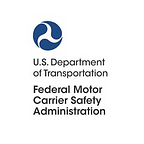FMCSA’s Response to the Key Bridge Collapse: Quick Action and Close Cooperation
“I had just joined the U.S. Department of Transportation’s Regional Emergency Cadre (RET-C) in January 2024 when I was deployed on March 26 to help manage the Francis Scott Key Bridge collapse,” said Maryann Durst, an FMCSA Maryland Division Office safety investigator since 2022.
The Cadre is part of the National Transportation Response and Recovery Program, and members represent all USDOT Operating Administrations and are highly trained subject matter experts who may be activated during an incident or event. In this case, Durst was on site at the emergency operations center in Hanover, MD, for the first two days following the incident to provide expertise on diverting commercial motor vehicle traffic around the collapsed bridge and how to adjust hours-of-service requirements in light of the diverted routing.
The U.S. Department of Transportation intermodal response included the Federal Highway Administration, FMCSA, National Highway Traffic Safety Administration, Office of the Secretary and Pipeline and Hazardous Materials Safety Administration. Federal agencies that responded included the Federal Emergency Management Agency, National Weather Service, U.S. Army Corps of Engineers, U.S. Coast Guard and U.S. Department of Homeland Security. State agencies that responded included the Maryland Department of Transportation as well as numerous other local agencies with Baltimore City and County that included infrastructure, environmental protection, fire/emergency services, human services, law enforcement, natural resources, public health, power infrastructure.
“I’d report back to the Division Office about what we did that day in a brief-out and talk about what we’re planning for response. We essentially were comparing notes on a daily basis,” Durst said.
Meanwhile, Maryland Division Office Administrator Robert King met early that morning with staff from FMCSA headquarters, the Eastern Service Center, the FMCSA Crisis Management Center and the Office of Safety, and was designated as the field liaison while Director of Office of Enforcement and Compliance Tom Liberatore was designated as the headquarters liaison as a way to streamline communications.
“The first week or two was pretty crazy. I felt like I was talking about the Key Bridge from sunup to sundown,” said King, who, as native of Maryland, remembered the Key Bridge opening in 1977.
King met with the Maryland Department of Transportation (MDOT), the Maryland Department of Motor Vehicles and CMV industry leaders to determine what the impact to transportation logistics would be due to the bridge being unusable for an extended and indefinite period of time. In light of the emergency declaration that the state of Maryland issued, he met continuously for the first two weeks of the disaster with 15 to 20 staff from FMCSA headquarters to discuss how the declaration would affect CMV traffic and how to transition from the expiration of the declaration to a temporary exemption for hours-of-service.
The Key Bridge is a major transportation artery for the Baltimore metro area as one of three key crossings running north-south, particularly for transporting hazardous materials. With the remaining two routes being restricted from transporting hazardous materials, the only route available was I-695. The Port of Baltimore was also closed following the collapse of the bridge, and intermodal transport of cargo that would normally go to Curtis Bay at the south end of the bridge now had to be diverted around the port to their destinations.
With the State of Maryland’s emergency declaration expiring on April 8, FMCSA implemented its own emergency declaration on April 4, and was extended multiple times until July 15. The emergency declaration extended hours-of-service and applied to transportation related to the immediate restoration of essential services and reopening of the Port of Baltimore and surrounding waterways; transportation related to commodities rerouted from the Port of Baltimore; and fuel transport in Baltimore and surrounding counties.
“After the lessons we learned from the exemptions we put in place during the COVID-19 pandemic, FMCSA was more surgical about implementing common-sense exemptions for the emergency period following the collapse,” said King, who has worked for FMCSA since 2008 and has experience as a truck dispatcher and Maryland state truck inspector. “There has been no increase in crashes due to the emergency declaration, which is a testament to our decision-making.”
Quick thinking from then-Acting Deputy Administrator Sue Lawless and Associate Administrator for Safety Darrell Ruban in their decision to streamline headquarters and field communications through Liberatore and King, respectively, made coordination efficient, organized and effective. Transportation Specialist Nicole Katsikides analyzed disaster and emergency operations data from MDOT and the University of Maryland’s Regional Integrated Transportation Information System, which Liberatore packaged with recommendations to be presented to Lawless and U.S. Secretary of Transportation Pete Buttigieg.
While the initial emergency period has been resolved, FMCSA’s Maryland Division Office continues to meet with state and industry partners today during the recovery and rebuilding phases of the response.
